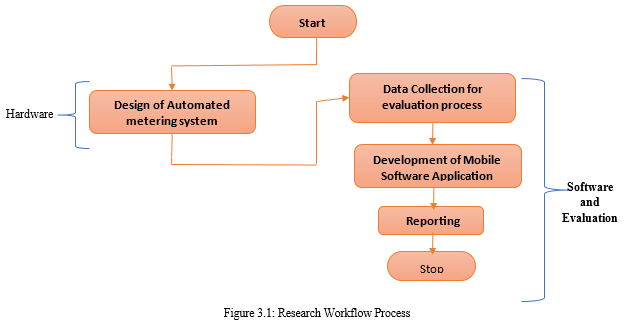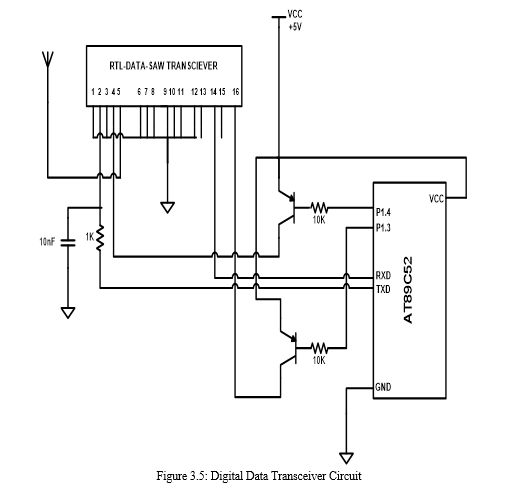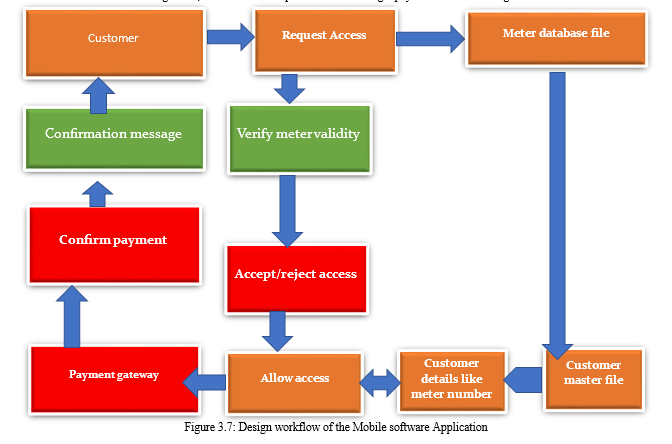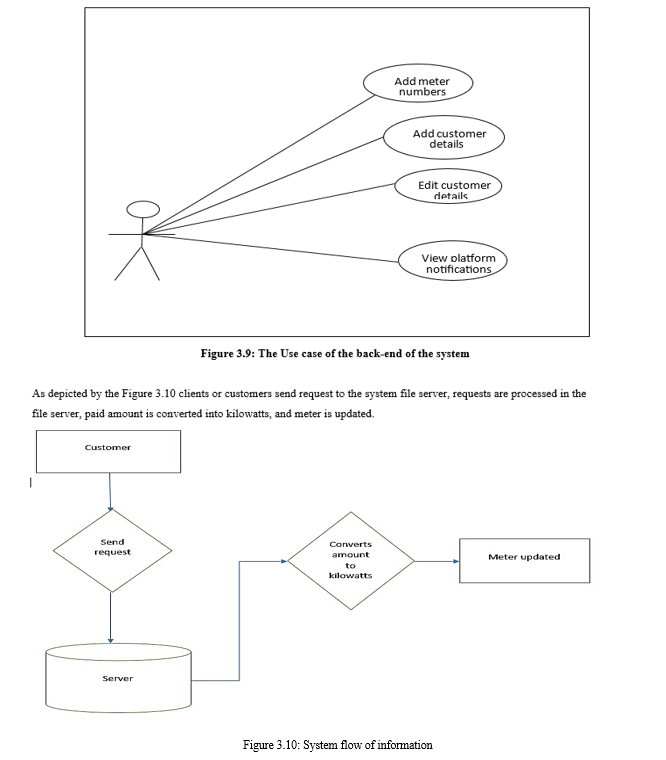Ijraset Journal For Research in Applied Science and Engineering Technology
- Home / Ijraset
- On This Page
- Abstract
- Introduction
- Conclusion
- References
- Copyright
Evaluation and Automation of Energy Consumption: A Tool for National Development
Authors: Edemirukaye U. Orodje, Mofunanya S.I., T. A. Olaniyan
DOI Link: https://doi.org/10.22214/ijraset.2024.53966
Certificate: View Certificate
Abstract
In developing countries like Nigeria, high energy inefficiency and poor technology have led to increased energy costs and wastage. This paper focuses on the second goal of the African Union Agenda 2063, which emphasizes the importance of science, technology, and innovation in creating well-educated citizens and a skills revolution. The objective is to investigate how evaluating and automating energy consumption can contribute to national development. The study utilizes a mixed-methods approach, gathering qualitative and quantitative data. The quantitative phase includes data collection from surveys via well-structured questionnaires to quantify energy usage patterns and assess the potential for automation. The qualitative phase includes in-depth interviews with energy users on their perspectives on energy evaluation and automation. For data analysis, ETAP, SPSS, and Microsoft Excel version 2016 are utilized. Consequently, hardware and software applications are developed to automate energy consumption through the utilization of a microcontroller and a mobile app. The key findings reveal eight loads measured over a year that an automated meter consumed 806.65 Joules of energy, whereas the existing meter consumed 1447.23 Joules. This demonstrates that automated systems consume less energy compared to the existing meters. The study emphasizes the significance of efficient energy consumption for achieving sustainable development goals and explores the potential of automation in optimizing energy usage. In conclusion, the paper provides recommendations for policymakers and stakeholders to enhance energy evaluation and automation in support of sustainable national development.
Introduction
I. INTRODUCTION
With increasing global concerns and the depletion of resources, efficient energy utilization has become a crucial element of national development strategies [1]. Energy consumption is vital for economic and societal growth across various sectors such as industry, transportation, and residential areas [1]. However, unsustainable energy practices and rising electricity demands pose significant challenges worldwide. As countries strive for sustainable development, it is important to assess and optimize energy consumption to ensure efficient resource utilization [2]. Traditional approaches to energy management often fall short in accurately analyzing consumption patterns and identifying areas for improvement [3]. In contrast, automation has the potential to revolutionize energy systems by providing real-time data, enabling remote monitoring [4], and facilitating intelligent decision-making.
By implementing smart sensors, intelligent algorithms, and energy management systems, It is now feasible to gather and analyze real-time data, optimize energy consumption, and reduce waste. [5]. Additionally, this research will explore the potential of demand response mechanisms, It enables customers to alter their energy consumption in response to price signals and grid conditions, thus fostering a more efficient and sustainable energy ecosystem [6]. Energy consumption significantly influences a nation's development trajectory [7]. Through optimized energy usage, countries can simultaneously achieve multiple developmental goals [8]. This thesis aims to investigate the benefits of evaluating energy consumption and implementing automation techniques for national development. It will examine how improved energy efficiency can contribute to economic competitiveness, job creation, and poverty alleviation [9]. Furthermore, it will assess the environmental impact of energy consumption patterns and explore ways to reduce carbon emissions, address climate change, and promote sustainable practices. The research will also consider policy implications, institutional frameworks, and regulatory mechanisms necessary to support the implementation of energy evaluation and automation strategies at a national level. Evaluating and automating energy consumption offer significant opportunities for countries to enhance their development, achieve sustainability targets, and ensure a prosperous future for their citizens. This paper aims to contribute to the understanding of effective strategies for evaluating energy consumption patterns and implementing automation techniques to optimize resource utilization, reduce environmental impact, and foster sustainable national development. By addressing critical aspects such as energy efficiency, technological integration, and policy frameworks, this research endeavor seeks to provide valuable insights to guide policymakers, industry stakeholders, and researchers in the pursuit of a sustainable energy future.
II. RELATED LITERATURE
A considerable number of studies have focused on analyzing energy consumption patterns and trends in various sectors and regions. For instance, Hennings et al. (2018) conducted an extensive examination of residential energy consumption patterns in Germany, identifying factors that influence energy usage. Similarly, Zhang et al. (2019) explored energy consumption trends in China's industrial sector and proposed strategies to enhance energy efficiency. These studies underscore the significance of comprehending energy consumption patterns to identify optimization opportunities and formulate targeted policies. In the realm of energy consumption modeling and forecasting, researchers have employed various approaches to predict energy demand accurately. For instance, Hong et al. (2017) utilized a long short-term memory (LSTM) neural network to forecast electricity consumption in South Korea. Likewise, Li et al. (2018) employed an autoregressive integrated moving average (ARIMA) model to predict residential energy demand. These studies highlight the potential of data-driven models in providing precise energy consumption forecasts for planning and decision-making purposes. In the field of smart grid technologies, Huang et al. (2016) investigated the implementation of a smart grid system in Singapore, with a specific focus on demand response and load management. Additionally, Huang et al. (2018) proposed a hierarchical framework for energy management in smart grids, which incorporated renewable energy sources and energy storage systems. These studies underscore the potential of smart grid technologies in enabling real-time monitoring, control, and automation of energy consumption.
Moreover, in relation to the Internet of Things (IoT) and automation, Al-Fuqaha et al. (2015) conducted a comprehensive survey on IoT-enabled smart cities, including applications for energy management. Similarly, Antonopoulos et al. (2018) proposed an IoT-based architecture for monitoring and controlling energy consumption in buildings. These studies emphasize the role of IoT in automating energy consumption and fostering sustainable practices. Regarding the relationship between energy efficiency and economic growth, Ang et al. (2015) conducted a meta-analysis of studies examining the link between energy efficiency and economic growth, finding a positive relationship between the two variables. Furthermore, Ohler et al. (2018) examined the impact of energy efficiency measures on job creation in the European Union. These studies highlight the potential of energy efficiency improvements to stimulate economic growth and generate employment opportunities.
However, it is important to note that despite the extensive body of work in the field, effective evaluation of automation of energy consumption and metering devices for national development remains limited. The aforementioned studies serve as the motivation for this research work, which seeks to address this gap and contribute to the understanding of effective strategies for evaluating and automating energy consumption to drive national development
III. METHODOLOGY

A. Development of Questionnaires and Data analysis
A set of fifteen (15) questions was developed for the questionnaires, with a structure that progresses from general to specific inquiries, aimed at assessing the respondents' awareness and everyday experiences regarding the importance of automation. This approach facilitated the identification of issues and requirements among electricity consumers. The survey was conducted by distributing questionnaires to the general public, specifically focusing on Obafemi Owode and its surrounding areas in Ogun State, Nigeria. To ensure a representative sample in proportion to the population, the Cochran formula was utilized for sample calculation.
. 
Where no is the sample size, z is the selected critical value of desired confidence level, p is the estimated proportion of an attribute that is present in the population, q = 1− p, and e is the desired level of precision. The data generated were analyzed using the Electrical Transient Analysis Program (ETAP), Statistical Package for Social Sciences, and Microsoft Excel.
B. Design Of The Hardware (Automated Metering System)
The design of the Automated metering system utilized the ADE7757 energy metering IC. In this design, the main role of the ADE7757 is to receive analog current and voltage signals generated by the current and voltage sense circuits, respectively. It then converts these analog signals into digital signals, multiplies them, and generates a digital signal with a frequency that corresponds to the obtained power value. The ADE7757 enhances energy measurement efficiency by producing instantaneous real power on its CF output pin.
The output energy waveform on the CF pin is shown in Figure 3.2

According to Figure 3.3, Pin 1 (VDD) is connected to the 5V output of the power supply unit, providing the necessary voltage for the ADE7757 circuitry. In order to maintain consistent performance, this pin is connected to both a 10μF capacitor and a ceramic 100nF capacitor in parallel for decoupling purposes, as specified in the datasheet.
Pins 2 and 3 (V2P, V2N) are the analog inputs for the voltage channel V2. The specified maximum differential input voltage for operation is +/-165mV, but for this design, a maximum differential input voltage of +/-109mV was chosen. Pin 2 is connected to the output of the voltage sense circuit, while pin 3 is connected to a 200?/150nF filter network for accurate signal measurement, as recommended in the datasheet.
Pins 4 and 5 (V1P, V1N) serve as the analog inputs for the current channel V1. The specified maximum differential input voltage for operation is +/-30mV, but for this design, a maximum differential input voltage of +/-20mV was selected. Pin 5 is connected to the output of the current sense circuit, while pin 4 is connected to a 200?/150nF filter network for precise signal measurement, as specified in the datasheet.
Pin 6 (AGND) functions as the ground reference for the analog circuitry within the ADE7757, such as the ADCs and reference. It is connected to the analog ground plane of the PCB, which serves as the ground reference for all analog circuitry, including the anti-aliasing filters, current and voltage sensors, etc.
Pin 7 (REF-IN/OUT) provides access to the on-chip voltage reference with a nominal value of 2.5V. To ensure stable operation, this pin is decoupled to AGND using a 1μF tantalum capacitor and a 100nF ceramic capacitor, as specified in the datasheet.
Pin 8, known as SCF, serves as the input for selecting the calibration frequency on the CF (calibration output). In this particular configuration, a frequency of 2.867 kHz was employed at the CF output. Consequently, the SCF switch remains open (turned off) as specified in the table.
On the other hand, pins 9 and 10, referred to as S0 and S1, function as logic inputs that allow the selection of one out of four available frequencies for the digital-to-frequency conversion process.

C. Design of the Microcontroller Circuit (AT89C52)
The microcontroller obtains the energy measurements from the ADE7757 through its CF pin, which provides a pulse train frequency output proportional to the measured power. The frequency is calibrated such that 100 pulses on the pin correspond to a power consumption of 0.01 kW. The microcontroller keeps track of the number of pulses generated on the CF pin while simultaneously starting its real-time clock. Once the count reaches 100 pulses, the microcontroller increments the stored energy value in memory by 0.01 kWh.

According to Figure 3.4, Pin 3 (P1.2) of the microcontroller receives the frequency output from the CF pin of the ADE7757 and keeps count of the pulses. Pin 4 (P1.3) of the microcontroller controls the transmitter section of the digital transceiver, powering it on or off depending on whether data transmission or reception is intended. Pin 5 (P1.4) controls the receiver section of the digital transceiver, powering it on or off when the meter is set to receive or transmit data.
Pin 10 serves as the serial input of the microcontroller, receiving serial data from the digital transmitter. Pin 11 functions as the serial output port of the microcontroller, sending serial data from the microcontroller to the transmitter section of the digital transmitter.
Pins 14, 15, and 16 are involved in LCD control. Pin 14 controls the RS (Register Select) function, pin 15 activates the RW (Read/Write) function when writing data to the LCD, and pin 16 enables or disables the LCD display.
Pins 21 to 28 form a parallel 8-bit port (port 2) of the microcontroller, responsible for transferring 8-bit data from the microcontroller to the LCD display.
Pins 18 and 19 are the input pins for the microcontroller's oscillator clock. In this design, an 11.092 MHz crystal was chosen as the clock frequency.
Pin 20 is the ground pin, connected to the digital ground of the meter, while pin 40 is the VCC (power supply) pin, connected to the 5V power supply.
D. The Digital Serial Transceiver Circuit
The digital serial transceiver used in this study is the RTF-DATA-SAW

According to Figure 3.5, Pin 2 serves as the digital serial data input to the transmitter section. It is connected to a 1KΩ/10nF low-pass filter, which limits the slew-rate of the keying signal and controls the transmitted bandwidth. In this design, it receives serial data from the output serial port of the AT89C52 microcontroller.
Pin 4 is the supply pin for the transmitter section, receiving a 5V power supply. When 5V is applied to this pin, the transmitter section is powered on. The power supply to this pin is controlled by pin 5 of the AT89C52 microcontroller using a PNP transistor, as depicted in Figure 3.5. Pin 5 is the output pin of the transmitter section and is connected to an external RF antenna measuring 16.5 cm in length.
Pin 13 is the analog output of the receiver section, but it is not utilized in this design.
Pin 14 serves as the digital data output of the receiver section and is connected to pin 10 of the AT89C52 microcontroller. It supplies the serial data received from the central base station to this pin of the microcontroller, which acts as the input serial port.
Pin 15 is not used in this configuration.
Pin 16 is the supply pin for the receiver section, receiving a 5V power supply. When 5V is applied to this pin, the receiver section is powered on. Similar to the transmitter section, the power supply to this pin is controlled by pin 4 of the AT89C52 microcontroller using a PNP transistor, as illustrated in Figure 3.5.
E. The ADE7757 Energy Meter
The complete circuit diagram of the ADE7757 energy meter is shown in figure 3.6.

When the load is supplied with electric power, the power supply unit energizes the meter, providing the necessary voltage to each component. The microcontroller undergoes an initialization process that involves the following steps: • Loading previous energy consumption values into its working registers • Initializing the LCD display unit to show the previously stored energy consumption values • Setting the transceiver to receiver mode by deactivating the transmitter section and activating the receiver section • Commencing the reading of energy values sent by the ADE7757 IC.
The current and voltage sense circuits capture the actual current and voltage signals across the line, respectively, and transmit them to the ADE7757 for measurement. The ADE7757 IC receives these signals, converts them into digital form, performs multiplication, and sends the resulting power (in variable frequency format) to the microcontroller. The microcontroller detects the power, calculates the consumed energy, and stores the measured power and energy values in memory. It continuously increments the energy value as more energy is measured. Additionally, it displays the current energy and power values on the LCD display every 2 seconds. When the transceiver, which is initially set to receive mode, receives a request from the central control and monitoring station, instructing the meter to transmit its energy readings, it compares the specified meter's serial number in the instruction with its own serial number. If there is a match, the microcontroller disables the receiver section and enables the transmitter section of the transceiver. It encodes the energy, power, and meter information using Manchester format and transmits this data via the transmitter section. After transmission, the transceiver switches back to receive mode and resumes measuring and storing power and energy consumption.
F. Design Of The Mobile Software Application
The primary objectives of this research were to develop and implement an automated prepaid meter system capable of instantly topping up electricity without the need for generating a token. These objectives were achieved through a step-by-step design workflow, consisting of iterative activities, as shown in Figure 3.7. Additionally, the design included the development of a use case for the Mobile App, the process encompassed various aspects such as the software development cycle, data collection methods, functional and non-functional requirements, methodology, and system development tools. After the design phase, the system was integrated and finalized to ensure its proper functioning. The diagram below provides a visual representation of how the electricity bill payment system operates, with the customer as the primary user. When the customer accesses the system and enters their meter number, the system checks for the validity of the meter number in the database. Depending on the validity, the user is either granted access or denied. If access is granted, the customer can proceed with making a payment and confirming the transaction.







V. FINDINGS
The key findings reveal eight loads measured over a year that an automated meter consumed 806.65 Joules of energy, whereas the existing meter consumed 1447.23 Joules. The findings demonstrate that evaluating and automating energy consumption can significantly contribute to national development. The study has revealed the importance of accurate energy evaluation in identifying areas for improvement and implementing targeted strategies. Moreover, automation technologies, such as Automated metering design with ADE7751 Energy meter IC, IoT devices like the Mobile Software Application, and data analytics, will play a pivotal role in optimizing energy consumption and enabling sustainable national development.
Conclusion
The research concludes that the evaluation and automation of energy consumption are vital tools for achieving sustainable national development. By adopting innovative technologies and approaches, policymakers and stakeholders can optimize energy usage, reduce waste, and contribute to economic growth and environmental preservation. The study provides recommendations for enhancing energy evaluation and automation strategies, emphasizing the need for supportive policies, investment in infrastructure, and public awareness. Through these efforts, nations can pave the way toward a more sustainable future, harnessing the power of energy consumption for national development.
References
[1] Ruth & Ali, \"Cultural factors of sustainable energy development: A case study of geothermal energy in Iceland and Japan,\" Elsevier, vol. 79, pp. 101-109, 2017. [2] Cainengzou et al, \"Progress, challenge and significance of building a carbon industry system in the context of carbon neutrality strategy,\" Elsevier, vol. 50, no. 1, pp. 210-228, 2023. [3] Kashif et al, \"The role of Financial Development and Technological Innovation towards Sustainable Development in Pakistan: Fresh insights from consumption and territory-based emissions,\" Elsevier, vol. 176, 2022. [4] Yue & Lima, \"Roles of artificial intelligence in construction engineering and management: A critical review and future trends,\" Elsevier, vol. 122, 2021. [5] Damminda & Xinghuo, \"Smart Electricity Meter Data Intelligence for Future Energy Systems: A Survey,\" IEEE, vol. 12, no. 1, pp. 425-436, 2016. [6] Mohsen et al, \"Internet of things for smart factories in industry 4.0, a review,\" Elsevier, vol. 3, pp. 192-204, 2023. [7] Michele et al, \"Understanding O-RAN: Architecture, Interfaces, Algorithms, Security, and Research Challenges,\" IEEE, vol. 25, no. 2, 2023. [8] Dolf et al, \"The role of renewable energy in the global energy transformation,\" Elsevier, vol. 24, pp. 38-50, 2019 [9] Nadine et al, \"The Contribution of Data-Driven Technologies in Achieving the Sustainable Development Goals,\" Mdpi, vol. 14, no. 5, 2022. [10] Nwona et al, \"Mapping synergies and trade-offs between energy and the sustainable development goals: A case study of off-grid solar energy in Rwanda,\" Elsevier, vol. 149, 2021.
Copyright
Copyright © 2024 Edemirukaye U. Orodje, Mofunanya S.I., T. A. Olaniyan . This is an open access article distributed under the Creative Commons Attribution License, which permits unrestricted use, distribution, and reproduction in any medium, provided the original work is properly cited.

Download Paper
Paper Id : IJRASET53966
Publish Date : 2023-06-12
ISSN : 2321-9653
Publisher Name : IJRASET
DOI Link : Click Here
 Submit Paper Online
Submit Paper Online

